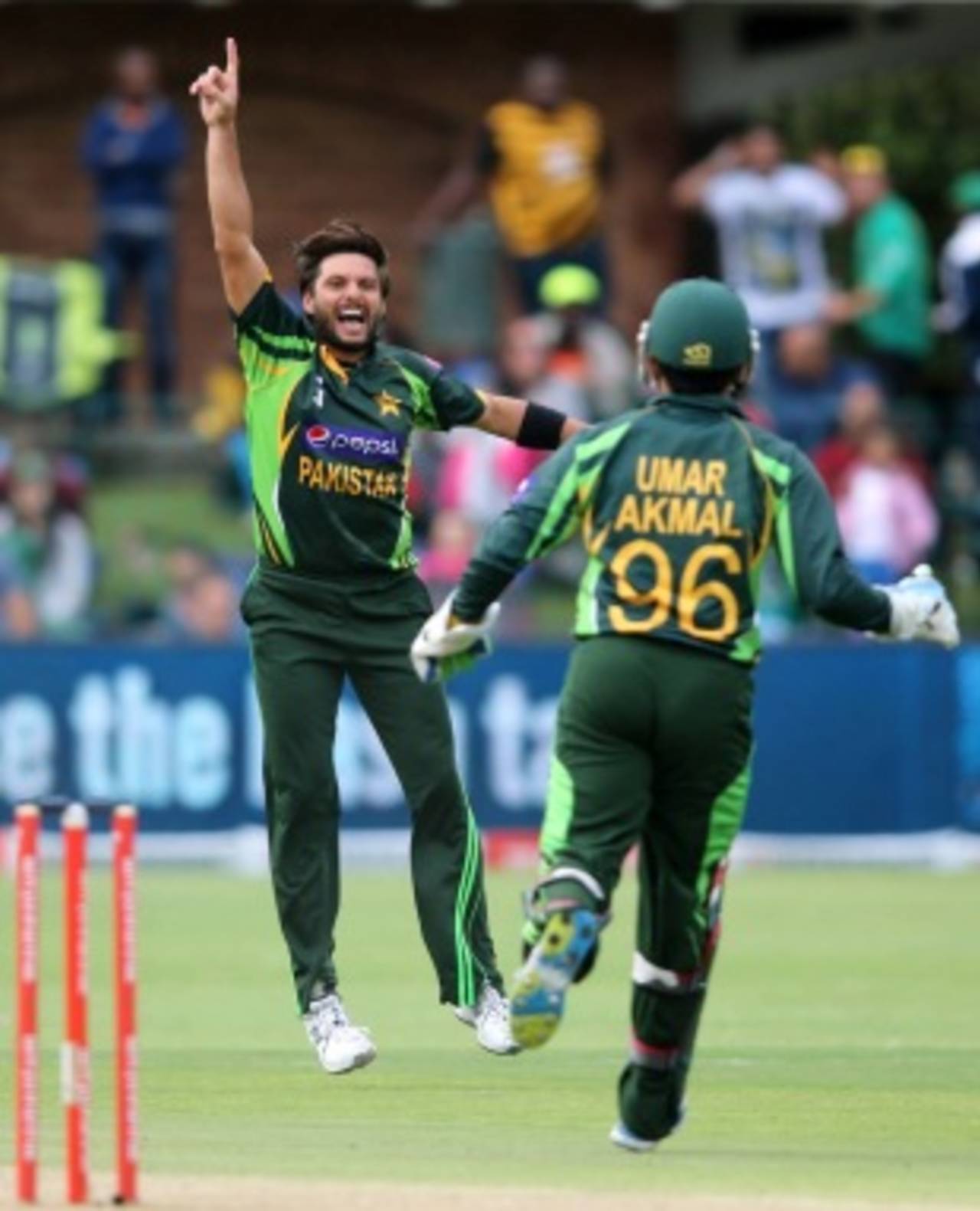A record for de Kock, and one for Taylor
Also, stumps as souvenirs, fastest to 4000 ODI runs, T20 allrounders, and Sydney's Brewongle Stand

Shahid Afridi: the first to score 1000 runs and take 50 wickets in T20Is • AFP
Quinton de Kock's remarkable effort against India - 135 in Johannesburg, 106 in Durban and 101 ain Centurion - made him only the fifth batsman ever to score three successive hundreds in one-day internationals, following Zaheer Abbas (in 1982-83), Saeed Anwar (1993-94), Herschelle Gibbs (2002-03) and AB de Villiers (2009-10). And de Kock's 342 runs overall did indeed break the record for a three-match bilateral series, which stood at 330, by New Zealand's Martin Guptill (103 not out, 189 not out, 38) in England earlier this year. Virat Kohli scored 357 runs in India's three matches - against different teams so not a bilateral series - in the Asia Cup in Bangladesh in March 2012.
You obviously put the "commentator's curse" on Ross Taylor, because he must have got out shortly after you wrote that! Taylor had successive innings of 217 not out, 16 not out and 129 in the recent Tests against West Indies - a total of 362 runs between dismissals. That is a record for New Zealand, beating Stephen Fleming's 343 (274 not out and 69 not out against Sri Lanka in Colombo in April 2003, followed by a duck in the next Test in Kandy). But Taylor is a fair way down the overall list, which is headed by Sachin Tendulkar, who made 497 runs between dismissals early in 2004 - 241 and 60, both not out, against Australia in Sydney in January, 194 not out against Pakistan in Multan in March, then out for 2 in the first innings of the next Test in Lahore. He beat the long-standing record of Garry Sobers, who made 490 runs - 365 not out and 125 - in successive innings against Pakistan in 1957-58. Seven others have had sequences of more than 400 runs between dismissals in Tests: Michael Clarke (489 in November 2012), Kumar Sangakkara (479 in 2007), Rahul Dravid (473 in November 2000), Jacques Kallis (456 in late 2001), Brian Lara (453 - 400 not out then 53 against England in 2004), Daryll Cullinan (427 in early 1999) and Mark Taylor (426 - 334 not out and 92 in the same match, for Australia v Pakistan in October 1998).
Actually the habit of grabbing souvenir stumps started well before that amazing match in Brisbane in 1960-61 - it was fairly well established even before a famous incident at the end of the first Test of the 1948 Ashes series, at Trent Bridge, when the controversial Australian opener Sid Barnes hit what he thought was the winning boundary, grabbed a stump and ran off. But actually he'd only tied the scores, and rather sheepishly had to come back - then took guard with the stump after handing his bat to the umpire to stick into the ground. Lindsay Hassett hit the vital single shortly afterwards, and because Barnes had to complete the winning run first he lost out in the scramble for souvenirs, and flung his bat down theatrically at the injustice of it all. I believe the authorities thought this sort of thing was rather unseemly, and tried to stop the practice for a while - which may be why no one went for the stumps at the end of the tied Test at the Gabba. Or they might just have been dazed by the remarkable finish - many of the players weren't sure of the result until they got back to the dressing rooms.
Hashim Amla reached 4000 runs in one-day internationals during his round 100 for South Africa against India in Durban last week. It was his 81st innings, in his 84th match - and both of those are easily records. Viv Richards reached 4000 in 88 innings from 96 matches: Virat Kohli also got there in 96 matches, but it took him 93 innings. The quickest to 4000 in terms of time was Rahul Dravid, in four years, minus about a week. MS Dhoni took about six weeks longer, and Kohli is next.
That's a nice easy one, because the answer is a resounding yes: Shahid Afridi, who currently has 73 wickets in T20 internationals, completed 1000 runs in the format when he passed 23 during Pakistan's match against Sri Lanka in Dubai last week. Only six other bowlers have reached the 50-wicket mark in Twenty20s so far, and of them only Umar Gul (160 runs) and Graeme Swann (106) have reached even three figures overall. The man closest to emulating Afridi's double is his team-mate Mohammad Hafeez, who currently has 44 wickets to go with 1250 runs.
The Brewongle Stand, which was rebuilt in 1980, sits at the southern end of the Sydney Cricket Ground. For years I thought it got its name because "brewongle" was an Aboriginal word, meaning something like "camping place", which perhaps reflected the fact that the SCG is in a big area of parkland. But a few years ago the industrious Sydney cricket historian Philip Derriman unearthed a more likely theory: that there used to be a tea-room inside the ground, where the new stand now is, called "The Brewongle". The cafe was taken over by two unmarried Sydney ladies in 1894, and they appear to have renamed it after their father's property outside Brewongle, near Bathurst to the west of Sydney. The father later sold up and moved to Sydney's Double Bay, and called his house there Brewongle too.
Steven Lynch is the editor of the Wisden Guide to International Cricket 2013. Ask Steven is now on Facebook